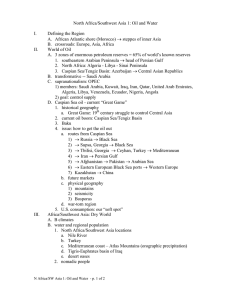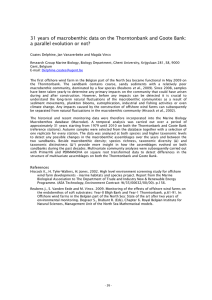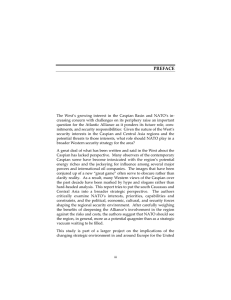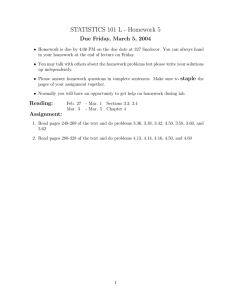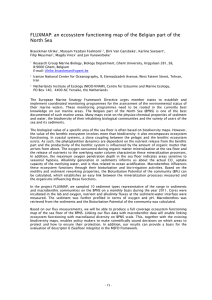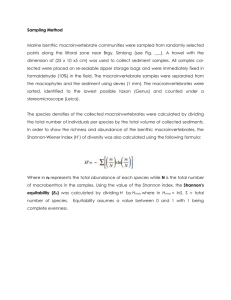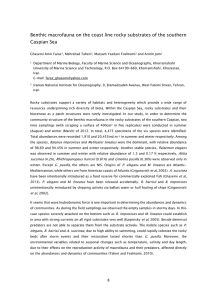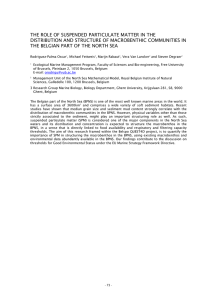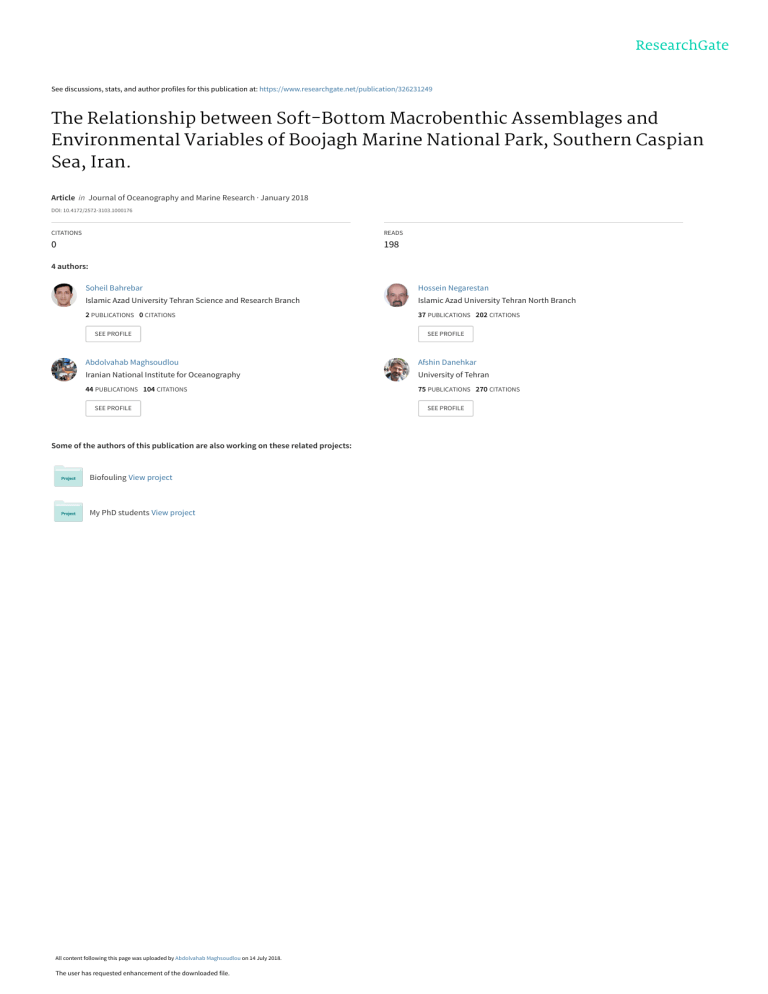
See discussions, stats, and author profiles for this publication at: https://www.researchgate.net/publication/326231249 The Relationship between Soft-Bottom Macrobenthic Assemblages and Environmental Variables of Boojagh Marine National Park, Southern Caspian Sea, Iran. Article in Journal of Oceanography and Marine Research · January 2018 DOI: 10.4172/2572-3103.1000176 CITATIONS READS 0 198 4 authors: Soheil Bahrebar Hossein Negarestan Islamic Azad University Tehran Science and Research Branch Islamic Azad University Tehran North Branch 2 PUBLICATIONS 0 CITATIONS 37 PUBLICATIONS 202 CITATIONS SEE PROFILE SEE PROFILE Abdolvahab Maghsoudlou Afshin Danehkar Iranian National Institute for Oceanography University of Tehran 44 PUBLICATIONS 104 CITATIONS 75 PUBLICATIONS 270 CITATIONS SEE PROFILE Some of the authors of this publication are also working on these related projects: Biofouling View project My PhD students View project All content following this page was uploaded by Abdolvahab Maghsoudlou on 14 July 2018. The user has requested enhancement of the downloaded file. SEE PROFILE of Oce nal an ur ne Resea ari r M raphy and og ISSN: 2572-3103 Journal of Oceanography and Marine Research ch Jo Research Article Soheil et al., J Oceanogr Mar Res 2018, 6:1 DOI: 10.4172/2572-3103.1000176 OpenAccess Access Open The Relationship between Soft-Bottom Macrobenthic Assemblages and Environmental Variables of Boojagh Marine National Park, Southern Caspian Sea, Iran Bahrebar Soheil1*, Negarestan Hossein2, Maghsoudlou Abdolvahab3 and Danehkar Afshin4 Department of Marine Biology, Science and Research Branch, Islamic Azad University, Tehran, Iran Department of Fisheries, Tehran North Branch, Islamic Azad Univerisy, Tehran, Iran 3 Department of Marine Science, Iranian National Institute for Oceanography and Atmospheric Science, Tehran, Iran 4 Department of Natural Resources, College of Agriculture and Natural Resources Tehran University, Tehran, Iran 1 2 Abstract Macrobenthic infauna and associated environmental factors influencing the benthic assemblages in the Southern coastal region of Caspian Sea were analyzed in five seasonal surveys from summer 2015 to summer 2016 (18 stations), in order to understand the assemblage structure and the factors influencing the benthic distribution. The results showed that sixteen macrobenthic species in total were collected from the research region. The composition of species was: Polychaeta (4 species); Mollusca (4); Crustacea (6); Clitellata (1) and Thecostraca (1), among which, all of species were common in the sampling of every season. The dominant species varied from season to season; however, the polychaete species Hypania invalida and Clitellata species Stenogammarus carausui were always present year-round. The results of CLUSTER analysis showed that the similarities of macrobenthic structures between the stations were low; most of the similarities in all seasons were at about 25-30% of similarity value, only two stations were up to 80%-90%. In accordance with the similarity values of the macrobenthic structures, we divided the 18 stations into five groups by the similarity level of 30%. Comparing sand percentages among transects, data based on Levene’s test were homogeneous (P>0.05). The results of one-way ANOVA showed that the differences between transects were highly significant (P<0.01). Results suggested that benthos was controlled by a combination of factors such as sediment structure, salinity, pH, the electrical conductivity, turbidity and temperature, and no single factor could be considered as a main influencing factor. Additionally, significant correlations between species abundances and the tested environmental factors were evident. This study highlights the potential consequences of established non-indigenous species in the Southern Caspian Sea. Keywords: Benthos; Biodiversity; Assemblage structure; Soft- bottom; Environmental; Caspian Sea; Boojagh marine national park (BMNP) Introduction While the Northern basin of Caspian Sea is extremely shallow (depth<25 m), the central and the Southern basins exhibit deep regions where depths reach approximately 800 and 1000 m, respectively [1,2]. Three main sources of inflows are present: river runoff (79%-80% of it coming from the Volga river), rainfall (20%) and groundwater inflow (1%) [3], while outflow is exclusively a result of evaporation. The salinity of the Caspian Sea is around a third of that of the oceans [4-6]. Changes in these factors such as organic matter, grading of sediment, pH, and redox potential affect the abundances of macrobenthos of sediments [7-13] Previous studies have determined a seasonal variation on macrobenthic assemblages with higher densities on spring followed by the lowest on summer [14,15]. Boojagh Marine National Park (BMNP), with an area of 3260 hectares, is a protected area in Astaneh Ashrafieh city of Gilan Province, Iran, being the first “coastal and terrestrial national park” established in the country. BMNP covers approximately 1,600 hectares of coastal area, 160 hectares of wetland meadows, and 1500 hectares of terrestrial areas [16-18]. At BMNP with a variable and diverse environmental conditions a wide range of macrobenthic assemblages might be expected. Due to its biodiversity importance a number of researchers focused on fauna and flora of this National Park [19-22]. Coastal waters of BMNP are to some extent affected by human activities such as pollutants of Sefidrood, port of Kiashahr and fishing activities so benthic study can be an efficient tool to evaluate these impacts [23,24]. However, the Caspian Sea suffers from both natural, e.g., sea level changes and anthropogenic disturbances e.g. pollution, eutrophication J Oceanogr Mar Res, an open access journal ISSN: 2572-3103 and invasive species [2]. The impact of the accidentally introduced ctenophore Mnemiopsis leidyi [25] has been tremendous on the Caspian ecosystem causing sharp decreases in macrobenthos densities, pelagic fish stocks and other higher components of the ecosystem [2628]. Some significant data have been obtained on the recent sea level fluctuations and their chronology, on the development of the Sefidrud River delta and surrounding low-lying plain through the Holocene [2,28-31]. Structure of benthic assemblages are frequently used in pollution effect monitoring programs [32-38]. In this paper we report the results of an analysis of macrobenthos of BMNP, Gilan Province using the data from July 2015 to August 2016. As such, this study attempted to understand the quantitative distribution (abundance) of macrobenthos in the BMNP of the Southern Caspian Sea in relation to seasonal changes in environmental parameters. Ultimately, the comprehensive assessment of factors affecting in this study facilitates a better understanding of the factors influencing in this area. Our aim is evaluate the spatial and temporal variations on macrobenthic total densities, species richness and diversity in the CS and its relation with environmental parameters (Figure 1). *Corresponding author: Bahrebar Soheil, Department of Marine Biology, Science and Research Branch, Islamic Azad University, Tehran, Iran, Tel: +201001565085; Fax: +98 21-33 34 69 17; E-mail: bahrebar.soheil@gmail.com Received March 19, 2018; Accepted May 22, 2018; Published May 29, 2018 Citation: Soheil B, Hossein N, Abdolvahab M, Afshin D (2018) The Relationship between Soft-Bottom Macrobenthic Assemblages and Environmental Variables of Boojagh Marine National Park, Southern Caspian Sea, Iran. J Oceanogr Mar Res 6: 176. doi: 10.4172/2572-3103.1000176 Copyright: © 2018 Soheil B, et al. This is an open-access article distributed under the terms of the Creative Commons Attribution License, which permits unrestricted use, distribution, and reproduction in any medium, provided the original author and source are credited. Volume 6 • Issue 1 • 1000176 Citation: Soheil B, Hossein N, Abdolvahab M, Afshin D (2018) The Relationship between Soft-Bottom Macrobenthic Assemblages and Environmental Variables of Boojagh Marine National Park, Southern Caspian Sea, Iran. J Oceanogr Mar Res 6: 176. doi: 10.4172/2572-3103.1000176 Page 2 of 6 Materials and Methods Also, Microsoft Excel was used for the calculation of location and dispersion of gathering environmental parameters [44]. Sampling Eighteen sampling stations were established in the coastal water of BMNP, Southern coast of the Caspian Sea, within the area of 37°24’45.37”N, 50°2’17.90”E. We sampled in the region every season, from July 2015 to August 2016: including summer 2015, autumn 2015, winter 2016, spring 2016 and summer 2016. Sediment samples were taken to study the macrobenthos by Van Veen grab with a sampling surface area of 0.22 m2. Each replicate was placed in a separate container and tagged with transect and sampling station specifications (Table 1). Then a 73 g/l solution of Magnesium Chloride was used to relax the species [39-43]. In the laboratory of Science and Research Branch of Islamic Azad University samples were fixed with 10% formalin. In order to identify macrobenthic invertebrates, samples were washed though a 0.5 mm mesh sieve. Specimens of the macrobenthos were sorted and identified with the help of microscope. Identified taxa were kept in 80% ethanol for further reference. Species were identified to the lowest possible level of taxonomy using Birshtain et al. as identification main reference with up to date corrections from World Register of Marine Species (WoRMS) reference website. To evaluate the significance of differences a one-way ANOVA was performed using SPSS 16 software and a post hock test of LSD was used to detect differences among sites. Transect season Season Winter 2015 Spring 2016 Summer 2016 Autumn 2016 The environmental factors were obtained in situ, including water depth, temperature, salinity, pH, turbidity, dissolved oxygen (hereafter referred to as DO). Among these, water depth, temperature and salinity Figure 1: Study area and sites of sampling, BMNP (6 transect; 18 sampling stations). TRANSECT SAND SILT TOM Turbidity (%) (%) (g/l) (m) Conductivity Salinity O2 (μz) (ppt) (g/l) 87.52 2.03 0.09 2 © 8.2 13.13 17 5.3 31 2 83.4 4.86 0.09 3 85.89 1.46 0.09 1.8 8.2 13.12 18 5.3 31 1.8 8.2 13.13 17 5.4 4 95.5 0.29 31 0.07 2.3 8.3 13.08 5 5.4 31 5 84.85 6 93.55 1.81 0.07 1.8 8.2 13.06 18 5.2 31 1.24 0.07 1.8 8.3 13.07 18 5.4 1 31 89.13 9.84 0.08 0.8 8.3 12.49 11 6.7 15.6 2 69.41 15.44 0.09 1 8.4 12.71 12 6.3 15.6 3 76.09 11.01 0.09 0.9 8.5 12.67 10 6.7 15.6 4 87.51 1.4 0.09 0.4 8.7 12.56 6 6.3 15.7 5 65.37 29.45 0.18 1.3 8.4 12.76 10 7.7 15.6 6 88.7 11.28 0.1 1.2 8.4 12.76 11 7.6 15.6 1 98.78 0.3 0.1 1.1 8.6 12.17 16 7.3 11.5 2 96.39 1.45 0.07 1 8.6 12.04 16 7.3 11.5 3 92.95 1.82 0.09 1 8.5 12.2 16 7.5 11.5 4 95.36 1.21 0.09 0.4 8.5 12.76 8 7.7 11.5 5 93.22 4.75 0.22 0.8 8.5 13 17 6.6 11.3 6 96.47 2.35 0.1 1.1 8.5 13.01 17 7.8 11.5 1 92.05 4.72 0.1 1.8 8.4 12.11 18 6.2 19.4 2 90.39 5.18 0.09 1.5 8.4 12.72 19 6.1 19.4 3 93.16 2.35 0.09 1.4 8.4 12.95 17 6.3 19.3 4 82.4 5.2 0.11 1.8 8.4 12.67 9 6.1 19.3 5 91.86 4.8 0.1 1.7 8.4 12.47 18 6.1 19.3 6 93.98 4.78 0.1 1.8 8.4 12.5 18 6.1 19.3 1 93.9 1.04 0.1 2.6 8.6 13.15 16 6.1 30 2 82.38 6.12 0.08 2.6 8.7 13.59 16 5.8 30 3 95.34 2.65 0.09 2.4 8.7 12.81 16 6.1 29.6 4 97.49 1.45 0.07 2.3 8.6 13.6 8 6 29.6 5 95.27 2.76 0.1 1.9 8.5 13.35 16 6 29.6 6 88.71 2.96 0.09 2.2 8.6 13.31 16 6.2 30 Transect 1 Autumn 2015 Environmental factors pH Temperature Table1: Localities of the sampling transect of BMNP with the sediment type and concentrations of organic matter (%). J Oceanogr Mar Res, an open access journal ISSN: 2572-3103 Volume 6 • Issue 1 • 1000176 Citation: Soheil B, Hossein N, Abdolvahab M, Afshin D (2018) The Relationship between Soft-Bottom Macrobenthic Assemblages and Environmental Variables of Boojagh Marine National Park, Southern Caspian Sea, Iran. J Oceanogr Mar Res 6: 176. doi: 10.4172/2572-3103.1000176 Page 3 of 6 were measured, turbidity was measured with a secchi disk, and for gathering sample water in different depth by Niskin bottle sampler. Statistical analysis Softwares of Plymouth Routines in Multivariate Ecological Research (PRIMER 6.0), SPSS 16.0 and Excel with office 2010 were used for the statistical analysis. The biological properties include abundance (A), the number of species (S), Shannon-Wiener diversity index (H_), Margalef richness index (d), and dominant index (Y). The dominant index of species was calculated by the following formulae: Y=(ni/N) × fi. (1) Where, N is the total abundance of all the stations; ni is the abundance of the species i of all the stations; fi is the occurring frequency of the species i of all the stations. In order to reduce the disturbance of the opportunistic species in the analysis of the biological properties of the macrobenthos, those species with their abundance proportions less than 1% in the whole abundance from the study region were deleted from the species of analysis, unless the species had more than 3% abundance proportion at any station of all the 18 stations. Results Analysis of environmental factors The first and most important factor for the distribution of macrobenthoses in some cases is salinity. The total minimum average of salinity was in the spring 2016 than in other seasons. In the case of pH, the review made, the pH somewhat more were reported at lower depths. The transparency of water at depths of 10 meters was much less than the other depths. Furthermore, the maximum depth of transparency was measured in summer and lowest depth of transparency in winter 2015. The amount of dissolved oxygen is somewhat similar assessment at different depths, but on closer examination at a depth of ten meters deep was found in the winter than in other seasons. In the case of the temperature also decrease at different depths somewhat similarly measured, but in different seasons was as follows: In the summer 2015, 31°C; in the autumn 2015, 15.6°C; in winter 2016, 11.5°C; in the spring 2016, 19.4°C and in summer 2016, 30°C. Species composition In this study according to Table 2, sixteen species were identified. Gastropoda represented the best taxon with 4 species (occupying 47.26% of all the species), followed by Crustacea with 6 species (19.60%), Polychaeta with 4 (13.22%) and Clitellata with 1 (9.09%) and other groups Barnacle with (10.8%). The total species number of each of the five sampling was different: As well as generally in summer 2015, Bivalves; in autumn 2015, Bivalves and Clitellata; in winter 2016, Bivalves and Polychaeta; the spring 2016 Bivalves and Cumacea and in summer 2016, Bivalves and Polychaeta were the largest and most of Macrobenthos of all five sampling, with one sampling in every season, sixteen species were identified as dominant species in the study area in accordance with their dominant values (P>0.05). Most of the species macrobenthos at a depth of ten feet and then five and one meter deep, respectively, were observed. A total of 5 chapters sampling, Gastropoda ranks highest with an average density of 588 per square meter, class malacostraca with an average of 225 per square meter, class polychaeta with an average of 175 per square meter, category lepadiform with an average of 109 per square meter finally clitellata class with an average density of 98 per square meter was the lowest. The results of analysis of variance benthic it should be noted that J Oceanogr Mar Res, an open access journal ISSN: 2572-3103 compared data on species Cerastoderma glaucum in the autumn 2015 of transect data on Levene’s test with homogeneity of variance were significantly (P>0.05). The Shapiro-Wilk normality test results showed that normal data were significantly (P>0.05). Based on the high number of tests it was found that there is a possibility of doing parametric analysis (Table 2). As a result, one-way ANOVA was performed and the results showed that the difference between transect there was very significant (P<0.01) (Table 3). LSD test results in the Fall 2015, according to the density of this species was divided into two groups in transect. Station 3 in transect 3, 4 and 5 had very significant difference with the rest of stations. It seems that this species tends to other deeper stations of eastern. This is probably due to Sefidrood river output is approaching nutrients such as transect 4 on the mouth of the river and around the transect 3 and 5. Class Bivalvia Gastropoda Order Family Species names Cardiida Cardiidae Cerastoderma glaucum Mytilaster lineatus Mytilida Mytilidae Littorinimorpha Hydrobiidae Pyrgula grimmi Hygrophila Planorbidae Anisus kolesnikovi Amphipoda Pontogammaridae Stenogammarus carausui Paraniphargoides motasi Uristidae Onisimus caspius Malacostraca Pterocuma pectinatum Cumacea Pseudocumatidae Pterocuma sowinskyi Pseudocuma (Stenocuma) gracile Hexanauplia Polychaeta Clitellata Sessilia Balanidae Terebellida Ampharetidae Hypania invalida Sabellida Fabriciidae Manayunkia caspica Spionida Spionidae Streblospio gynobranchiata Phyllodocida Nereididae Hediste diversicolor Haplotaxida Tubificidae Nais sp. Amphibalanus improvisus Table 2: Identified species in the 5 seasons from summer 2015 until summer 2016. ANOVA Sum of squares Degrees of freedom Mean square F P Between groups 1111.200 17 65.365 3.860 0.000 Within groups 1219.200 72 16.933 - - Total 2330.400 89 - - - Table 3: One-way ANOVA, samples Cerastoderma glaucum species in BMNP, Caspian Sea. Figure 2: Shannon biodiversity index at various stations in total sampling period (5 chapters) from summer 2015 to summer 2016 BNMP (Error bars show standard deviation). Volume 6 • Issue 1 • 1000176 Citation: Soheil B, Hossein N, Abdolvahab M, Afshin D (2018) The Relationship between Soft-Bottom Macrobenthic Assemblages and Environmental Variables of Boojagh Marine National Park, Southern Caspian Sea, Iran. J Oceanogr Mar Res 6: 176. doi: 10.4172/2572-3103.1000176 Page 4 of 6 Biodiversity According to Shannon index, most stations were good in most seasons biodiversity, including stations with good biological diversity can be noted in the following stations: Figures 2 and 3 show the two biodiversity indices of the macrobenthos at all stations in five seasons. All stations that were located at a depth of 10 meters (S3). The depth of 5 meters stations was also somewhat appropriate that this well is visible on the graph. Discussion Tajalipour [45] examined the Iranian coast of the Caspian Sea and he divided coastal zone into eleven sections, each station at depths of 5-200 m with three replications because ampharetids and S. gynobranchiata inhabit similar habitats and are both considered surface deposit feeders [46], it appears that S. gynobranchiata is able to outcompete native ampharetids in shallow waters and displace them to greater depths in the Southern Caspian Sea. Likewise, because H. diversicolor occupy overlapping habitat, they are also potential competitors [47]. Because H. diversicolor preys on larger organisms [48], H. diversicolor becomes suppressed increases in abundance [49]. Hence, H. diversicolor is usually confined to fresher waters, greater depths, and high-sulfidic sediment areas where it is able to tolerate extreme conditions, albeit at the expense of competitive ability [50,51]. For example, the introduction of macrobenthos into aquaculture pens resulted in increased species richness, enhanced the productivity and biomass of benthic fauna, and improved environmental conditions for fish production by reducing the organic matter content in sediments [52]. Also, in comparing data related to oligochaete, Nais sp. To solve the problem of data transfer with reflow was used. After transferring the homogeneity of variance Levene test results significant (P>0.05) and Shapiro-Wilk normality test results significantly (P>0.05). Based on the high number of tests it was found that the possibility of doing parametric analysis after transferring there. LSD test results in the Fall 2015, according to the density of this species was divided into two groups of in transect. Stations 2 and 3 in transect 5 had significant difference from the rest of the stations in all transect, of course transect and station 3 was very significant difference to all stations even two stations have the same transect. It seems the station and partly station 2 in this transect environment is appropriate to increase the density of these oligochaet. Figure 3: Simpson biodiversity index at various stations in total sampling period (5 chapters) from summer 2015 to summer 2016 BNMP (Error bars show standard deviation). J Oceanogr Mar Res, an open access journal ISSN: 2572-3103 The effect of stress based on their population structure parameters are detected [53]. Several studies also prove that anthropogenic activities and environmental factors would influence the spatial and temporal distributions of macrofaunal abundance and biomass [5456]. Furthermore, significant correlations between macrobenthos abundance and percentages of silt–clay and various sand types were also observed in the current study. These observations suggest that sediment grain size and %TOM may be influential contributors to macrobenthic assemblage composition; similar suggestions have been made by others [57,58]. McIntyre [59] suggested that, coupled with the direct operation of temperature and salinity, grain size operates indirectly to control the distribution of benthic organisms. In brackish waters, salinity is an important factor influencing the spatial distribution of animals [60] and is considered the most important abiotic factor in the Caspian Sea [61]. Historically, Caspian endemic species adapted to inhabit fresher waters of the northern Caspian Sea [62]. As such, lower diversity in the Southern Caspian Sea could be related to higher salinities [62]. Species introductions can have both positive and negative impacts on their invaded such as different ecosystems. Ecological impacts of invasions are often inferred by assuming that impacts become more severe as non-indigenous species (NIS) become more abundant and widespread. However, studies where distribution and abundance of NIS can be evaluated relative to native species are typically conducted at restricted spatio-temporal scales in areas known to be infested, potentially overestimating the importance of the NIS over broader scales [63]. The geographical range of several species has been increased by human activities, both intentionally (e.g. aquaculture) and unintentionally (e.g. interconnection of water basins through canals; shipping activities) [64]. As such, many invasive species have arrived in the Caspian Sea. For example, the oligochaete Tubificoides fraseri and polychaete S. gynobranchiata have been unintentionally introduced into the Caspian Sea [65], most likely through the Volga Don canal, which opened in 1954. Additionally, H. diversicolor and have been intentionally introduced to the Caspian Sea to increase food resources for commercially exploited fish [65]. Consequently, in the Caspian Sea, these worms represent a significant food resource for commercially valuable fish and could potentially facilitate the recovery exploited fish stocks. Because these invasive macribenthos are usually dominant taxa in benthic assemblages of the Caspian Sea, they could be utilized as indicator species of environmental conditions [66]. In addition, errantia worms, could potentially enhance the oxygenation, organic matter mineralization decomposition, nutrient accessibility and bacterial activity of sediments by means of bioturbation [67,68]. Ellingsen [69] studied macrobenthic infauna in relation to environmental variability in Norway and found that the best correlative variable combination included depth, median grain size and silt–clay content. Nevertheless, physical disturbance and chemical contamination in sediment may have higher effects on macrobenthic infauna than sediment characteristics in coastal waters [70]. Han et al. [71] studied the macrobenthic assemblage structure in the eastern and central Bohai Sea and reported that “water depth and nitrate concentration in the bottom water, followed by microfauna abundance, had the closest relationships with the macrobenthic assemblage”. Jayaraj et al. [72] studied the macrobenthos and associated environmental factors in the northwest Indian shelf, and thought that “benthos were controlled by a combination of factors such as temperature, salinity, dissolved oxygen, sand and organic matter and no single factor could be considered as an ecological master factor” [73,74]. Although the establishment of these some nonindigenous macrobenthos as an additional food source could facilitate the rehabilitation of commercially exploited fish stocks, the consequences for native benthic assemblages remain unclear. As such, Volume 6 • Issue 1 • 1000176 Citation: Soheil B, Hossein N, Abdolvahab M, Afshin D (2018) The Relationship between Soft-Bottom Macrobenthic Assemblages and Environmental Variables of Boojagh Marine National Park, Southern Caspian Sea, Iran. J Oceanogr Mar Res 6: 176. doi: 10.4172/2572-3103.1000176 Page 5 of 6 benthic assemblages are at risk of being subjected to unforeseen negative impacts. Ultimately, NIS have the potential to provide many favorable ecosystem services and enhance the overall health of an ecosystem; however, further studies are required to monitor the potential impacts of these non-indigenous macrobenthos on the benthic assemblages of the Caspian Sea. Conclusion Our recent study showed that the salinity, temperature and sand in the research region were the most important factors impacting the assemblage structure of macrobenthos and without “one master factor” controlling the macrobenthos assemblage. The combination of factors of concentrations of sand and temperature would impact mainly the assemblage structure of macrobenthos. Our results are different from that of the above mentioned, which may be due to the different environmental factors in the water regions. References 1. Parr TD, Tail RD (2010) A descriptive account of benthic macrofauna and sediment from and area of planned petroleum exploration in the southern Caspian Sea. Estuar Coast Shelf Sci 71: 170-180. 2. Dumont HJ (1998) The Caspian Lake: History, biota, structure, and function. Limnol Oceanogr 43: 44-52. 3. Zenkevitch LA (1963) Biology of the seas of the U.S.S.R. Interscience Publishers, New York. p: 972. 4. Fauchald K, Jumars PA (1979) The diet of worms: A study of polychaete feeding guilds. Oceanogr Mar Biol 17: 193-294. 5. Surugiu V, Revkov N, Todorova V, Papageorgiou N, Valavanis V, et al. (2010) Spatial patterns of biodiversity in the Black Sea: An assessment using benthic polychaetes. Estuar Coast Shelf Sci 88: 165-174. 6. Castro P, Huber M, Huber ME (2008) Marine Biology. 8th edn. Mcgraw Hill, New York, USA. 7. Hakanson L (1980) An ecological risk index for aquatic pollution control: A sedimentological approach. J Water Res 14: 975-1001. 8. Wright P, Mason CF (1999) Spatial and seasonal variation in heavy metals in the sediments and biota of two adjacent estuaries, the Orwell and the Stour, in eastern England. Sci Total Environ 226: 139-156. 9. Tam, NFY, Wong YS (2000) Spatial variation of heavy metals in surface sediments of Hong Kong mangrove swamps. Environ Pollut 110: 195-205. 10. Buccolieri A, Buccolieri G, Cardellicchio N, Atti AD, Leo AD, et al. (2006) Heavy metals in marine sediments of Taranto Gulf (Ionian Sea, Southern Italy). J Mar Chem 99: 227-235. 19. Khara H, Nezam SA, Sattari M, Mirhasheminasab DF, Mousavi SA (2006) An investigation on digestive parasites of fishes in Boojagh Wetland, North Iran. Iran J Fish Sci 15: 9-18. 20. Ashuri A, Nezami S, Zolfinejad K (2008) Identification of boojagh national park kiashahr birds. J Environ Stud 34: 101-111. 21. Yousefi A, Bahmanpour H, Salajegheh B, Dashti S (2013) Survey of birds in microhabitats of national park in boujagh wetland. J Wetland Ecobiol 5: 19-32. 22. Coad BW (2016) Review of the pikes of Iran (Family Esocidae). Iran J Ichtiyol 3: 161-180. 23. Taheri M, Yazdani M, Noranian M, Mira SS (2012) Spatial distribution and biodiversity of macrofauna in the southeast of the Caspian Sea, Gorgan Bay in relation to environmental conditions. Oceanol Sci J 47:113-122. 24. Roody SA (2012) A preliminary study of benthic fauna in southern coastal waters of the Caspian Sea. Iran Fish Sci J 3:41-56. 25. Ivanov PI, Kamakin AM, Ushivtzev VB, Shiganova T (2000) Invasion of the Caspian Sea by the comb jellyfish Mnemiopsis leidyi (Ctenophora). Biol Invasions 2: 255-258. 26. Shiganova TA, Kamakin AM, Zhukova OP, Ushivtzev VB, Dulimov AB, et al. (2001) An invader in the Caspian Sea: Ctenophore Mnemiopsis and its initial effect on pelagic ecosystem. Mar Biol 41: 517-524. 27. Kideys AE, Finenko G, Anninsk B, Shiganova T, Roohi A, et al. (2004) Physiological characteristics of the ctenophore Beroe ovata in the Caspian Sea water. Mar Ecol Prog Ser 266: 111-121. 28. Calabretta C, Oviatt C (2008) The response of benthic macrofauna to anthropogenic stress in narraganset bay, Rhode Island: A review of human stressors and assessment of assemblage conditions. Marine Poll Bull 56: 1682-1695. 29. Richards K, Leroy SAG, Arpe K, Marret F, Hoogendoorn RM, et al. (2011) Fluctuations in Caspian Sea level during the quaternary: New evidence from palynology and climate modeling. 3rd International Symposium on the Geology of the Black Sea Region, At Bucharest, Romania. 30. Kakrodi AA, Kroonenberg SB, Hoogendoorn RM, Mohammad Khani H, Yamani M, et al. (2012) Rapid holocene sea-level changes along the Iranian Caspian coast. Quat Int 263: 93-103. 31. Kazanci N, Gulbabazadeh T (2013) Sefidrud delta and quaternary evolution of the southern Caspian lowland. Mar Pet Geol 44: 120-139. 32. Snelgrove R (1998) The biodiversity of macrofaunal organisms in marine sediments. Biodivers Conserv 7: 1123-1132. 33. Wang J, Huang X (2004) Tendency of the biodiversity variation nearby Changjiang estuary. Mar Sci Bull. 34. Tang Q (2006) Marine biological resource and inhabited environment in Chinese exclusive economic zone. China, Beijing. 11. ElNemr AH, El Sikaily A, Khaled A (2007) Total and leachable heavy metals in muddy and sandy sediments of Egyptian coast along Mediterranean Sea. Environ Monit Assess 129: 151-168. 35. Yamamuro M (1987) Macrobenthic faunas of two brackish lagoons with different salinity in Kamikoshiki Island, Kagoshima Prefecture. Jap J Limnol 48: 177-186. 12. Warwick M (1986) A new method for detecting pollution effects on marine macrobenthic communities. J Mar Biol 92: 557-562. 36. Tsujimoto A (2008) Development of modern benthic ecosystems in eutrophic coastal oceans: The foraminiferal record over the last 200 years, Osaka Bay, Japan. Mar Micropaleontol 69: 225-239. 13. Takeoka H (2002) Progress in Seto Inland Sea research. J Oceanogr 58: 93-107. 14. Afli A, Ayari R, Zaabi S (2008) Ecological quality of some Tunisian coastal and Lagoon locations, by using benthic assemblage parameters and biotic indices. Estuar Coast Shelf Sci 34: 269-280. 15. Tamai K (1993) Tolerance of Theora fragilis (Bivalvia: Semelidae) to low concentrations of dissolved oxygen. Nippon Suisan Gakk 59: 615-620. 16. Safari H (1976) Identification of Boojagh Conservation Area. A report for Department of the Environment Office, Gilan Province, Rasht, Iran. 17. Vosoughi G, Mostajir F, Motamed A (2000) Freshwater fish. 3 edn. Tehran University Press, Tehran, Iran. rd 18. Roohi A, Kideys AE, Sajjadi A, Hashemian A, Pourgholam R, et al. (2010) Changes in biodiversity of phytoplankton, zooplankton, fishes and macrobenthos in the Southern Caspian Sea after the invasion of the ctenophore Mnemiopsis leidyi. Biol Invasions 12: 2343-2361. J Oceanogr Mar Res, an open access journal ISSN: 2572-3103 37. Puente A (2008) Ecological assessment of soft bottom benthic communities in northern Spanish estuaries. Ecol Indic 8: 373-388. 38. Huber ME (2010) Marine biology. ICZM Report. 3rd edn. Mac Grave Hill 21: 446. 39. Souza JRB, Gianuca NM (2005) Zonation and seasonal variation of the intertidal macrofauna on a sandy beach of Parana state, Brazil. Sci Mar 59: 103-111. 40. Elliott B (2006) Intertidal zonation of macroinfauna on a dissipative, sandy beach at Panne (Belgium): A pilot study. Biol Jaarb Dodonaea 64: 92-108. 41. Holtmann SE (2006) Atlas of the zoobenthos of the Dutch continental shelf. Ministry of Transport, Public Works and Water Management, North Sea Directorate. p: 244. 42. Dauvin JC (2008) The fine sand Abra alba assemblage of the Bay of Morlaix twenty years after the Amoco Cadiz oil spill. Mar Poll Bull. Volume 6 • Issue 1 • 1000176 Citation: Soheil B, Hossein N, Abdolvahab M, Afshin D (2018) The Relationship between Soft-Bottom Macrobenthic Assemblages and Environmental Variables of Boojagh Marine National Park, Southern Caspian Sea, Iran. J Oceanogr Mar Res 6: 176. doi: 10.4172/2572-3103.1000176 Page 6 of 6 43. Creutzberg F, Wapenaar P (2014) Distribution and density of benthic fauna in the southern North Sea in relation to bottom characteristics and hydrographic conditions. Rapp et Proc-Verb Cons Int Explor Mer 183: 101-110. 44. Birshtain YA, Vinogradova LG, Kondakov NN, Koon MS (1966) Atlas of invertebrates of the Caspian Sea. 45. Tajalipour M (1979) Study animals Caspian Sea (Astara-Anzali), University of Ahvaz. 46. Taheri M, Seyfabadi J, Abtahi B, Yazdani M (2009) Population changes and reproduction of an alien spionid polychaete, Streblospio gynobranchiata, in shallow waters of the south Caspian Sea. Mar Biodivers Rec 2: 1-5. 47. Wolff WJ (1973) The estuary as a habitat: An analysis of data on the softbottom macrofauna on the estuarine area of the rivers Rhine, Meuse Scheldt. Zool Verkan 126: 1-242. 48. Rasmussen E (1973) Systematics and ecology of the Isefjord marine fauna (Denmark). Ophelia 11: 1- 507. 49. Smith RI (1963) On the occurrence of Nereis (Neanthes) succinea at the Kristineberg Zoological Station, Sweden and its recent northwards spread. Arkiv För Zoologi 15: 437-441. 50. Kristensen E (1988) Factors influencing the distribution of nereid polychaetes in Danish coastal waters. Ophelia 29: 127-140. 51. Miron G, Kristensen E (1993) Factors influencing the distribution of nereid polychaetes: The sulfide aspect. Mar Ecol Prog Ser 93: 143-153. 52. Carvalho S, Barata M, Gaspar MB, Pous P, Cancela da Fonseca L (2007) Enrichment of aquaculture earthen ponds with Hediste diversicolor: consequences for benthic dynamics and natural productivity. Aquaculture 262: 227-236. 53. Karpinsky MG (2010) Review: The Caspian Sea benthos: Unique fauna and assemblage formed under strong grazing pressure. Mar Poll Bull 61: 156-161. 54. Drake P, Arias AM (1997) The effect of aquaculture practices on the benthic macroinvertebrate community of a lagoon system in the Bay of Cádiz (Southwestern Spain). Estuaries 20: 677. 55. Magni P, Micheletti S, Casu D (2005) Relationships between chemical characteristics of sediments and macrofaunal communities in the Cabras lagoon (Western Mediterranean, Italy). Hydrobiologia 550: 105-119. 56. Magni P, Como S, Montani S (2006) Interlinked temporal changes in environmental conditions, chemical characteristics of sediments and macrofaunal assemblages in an estuarine intertidal sandflat (Seto Inland Sea, Japan). Mar Biol 150: 529-529. 57. Diaz-Castaneda V, Harris L (2004) Biodiversity and structure of the polychaeta fauna from soft bottoms of Bahia Todos Santos, Baja California, Mexico. Deep Sea Res Part II. Top Stud Oceanogr 51: 827-847. J Oceanogr Mar Res, an open access journal ISSN: 2572-3103 View publication stats 58. Nybakken JW (1993) Marine biology: An ecological approach. 3rd edn. Harper Collins College Publishing, New York. p: 462. 59. McIntyre AD (1969) Ecology of marine meiobenthos. Biol Rev 44: 245-290. 60. Leppkoski E, Olenin S (2000) Xenodiversity of the European brackish water seas: The North American contribution. In: Marine Bioinvasions. Proceedings of the First National Conferences. Pederson J (ed) Massachusetts Institute of Technology 23: 107-119. 61. Aladin NV, Plotnikov I (2004) The Caspian Sea: Lake Basin management initiative. Thematic Paper: 1-29. 62. Kasymov AG (2004) Abundance of zooplankton and zoobenthos in Baku Bay, Caspian Sea. Oceanology 28: 524-526. 63. Thomsen MS, Wernberg T, Silliman BR, Josefson A (2009) Broad-scale patterns of abundance of non-indigenous soft-bottom invertebrates in Denmark. Helgol Mar Res 63: 159-167. 64. Bij de Vaate A, Jazdzewski K, Ketelaars HAM, Gollasch S, Van der Veld G (2002) Geographical patterns in range extension of Ponto-Caspian macro invertebrate species in Europe. Can J Fish Aquat Sci 59: 1159-1174. 65. Ghasemi AF, Taheri M, Jam A (2013) Does the introduced polychaete Alitta succinea establish in the Caspian Sea? Helgol Mar Res 67: 715-720. 66. Dumont HJ (2000) Endemism in the Ponto-Caspian fauna, with special emphasis on the Onychopoda (Crustacea). Adv Ecol Res 31: 181-196. 67. Bartoli M, Nizzoli D, Welsh DT, Viaroli P (2000) Short-term influence of recolonisation by the polychaete worm Nereis succinea on oxygen and nitrogen fluxes and denitrification: A microcosm simulation. Hydrobiologia 431: 165-174. 68. Heilskov AC, Holmer M (2001) Effects of benthic fauna on organic matter mineralization in fish-farm sediments: Importance of size and abundance. ICES J Mar Sci 58: 427-434. 69. Ellingsen K (2012) Soft sediment benthic biodiversity on the continental shelf in relation to environmental variability. Mar Ecol Prog Ser 232: 15-27. 70. Lu L (2005) The relationship between soft-bottom macrobenthic assemblages and environmental variables in Singaporean waters. Marine Poll Bull 51: 1034-1040. 71. Han J, Zhang Z, Yu Z (2004) Macrobenthic assemblage structure in the eastern and central Bohai Sea, China. Acta Ecol Sin 24: 531-537. 72. Jayaraj K, Jayalakshmi K, Saraladevi K (2007) Influence of environmental properties on macrobenthos in the Northwest Indian shelf. Environ Monit Assess 127: 459-475. 73. Zimmerman AR, Canuel EA (2000) A geochemical record of eutrophication and anoxia in Chesapeake Bay sediments: Anthropogenic influence on organic matter composition. Mar Chem 69: 117-137. 74. Schlitzer R (2002) Interactive analysis and visualization of geoscience data with ocean data View. Comput Geosci 28: 1211-1218. Volume 6 • Issue 1 • 1000176
